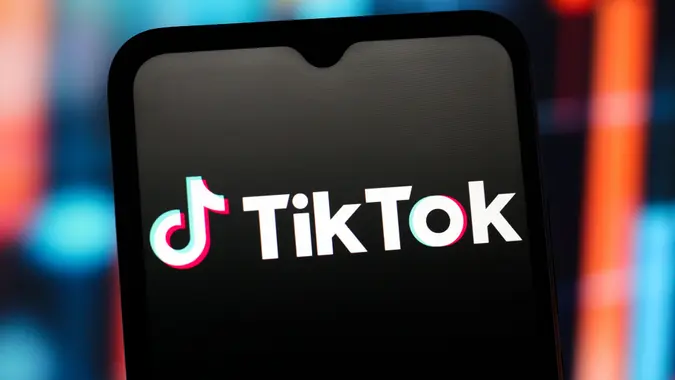Balance Transfer vs. Personal Loan: What’s the Difference?

Commitment to Our Readers
GOBankingRates' editorial team is committed to bringing you unbiased reviews and information. We use data-driven methodologies to evaluate financial products and services - our reviews and ratings are not influenced by advertisers. You can read more about our editorial guidelines and our products and services review methodology.

20 Years
Helping You Live Richer

Reviewed
by Experts

Trusted by
Millions of Readers
Balance transfers and personal loans are both options you can consider if you need to pay down debt and are looking to minimize interest rates.
Key Differences Between Balance Transfer and Personal Loan
| Feature | Balance Transfer | Personal Loan |
|---|---|---|
| How funds are received | You transfer your existing debt to a new card | You take out a loan for the amount of money you need to pay off your debt |
| Interest type | Intro 0% APR for paying off balance transfer applies for a specified timeframe, generally 15-18 months | You’ll generally pay a fixed interest rate over the life of the loan |
| Collateral required? | No | Usually not |
| Best for | Paying off debt if you’re sure that you’ll be able to do so within a specific frame of time | Paying off debt if you want to reduce your interest rate but need a longer term, such as a few years |
| Credit needed | Good to excellent | Fair or better in order to get the best rates |
| Common uses | Paying off existing debt while avoiding interest with an introductory 0% APR period | Consolidating debt to reduce interest rate, paying off unexpected expenses |
What Is a Balance Transfer?
A balance transfer is a way of moving existing debt to a new account to secure a lower interest rate. Balance transfers generally work with credit cards, and you can only transfer an amount up to your approved credit limit on the new balance transfer card.
How a Balance Transfer Works
Say you have an existing debt of $10,000 on a credit card with a 21% APR. You’ve found another card with a 15-month 0% APR introductory period and are approved.
- Move that $10,000 balance over to the new card
- You’ll have 15 months to pay off your balance before the card begins charging interest.
- Most balance transfer cards charge a balance transfer fee of 3% to 5% of the amount you transfer.
- If you aren’t able to pay off your entire balance by the time the introductory period ends, you’ll be on the hook to pay interest on the remaining balance, likely at a high interest rate.
Balance transfers are generally used by individuals with existing debt who want to minimize or even avoid interest payments.
If you have a plan to pay off your balance by the time the introductory period is over, your only cost could be the balance transfer fee you’ll pay to move your balance over at the beginning — unless you can find a card that waives the balance transfer fee, which is becoming more difficult to find and may only be offered to targeted bank customers.
You can find balance transfer cards through both major and regional banks as well as credit unions and online-only banks.
What Is a Personal Loan?
A personal loan is different because you request to borrow the amount of money you need to pay off your debt from a lender, and you’ll repay the loan over time with interest. Here’s how to decide which is right for you.
A personal loan is money you borrow to either pay off or consolidate existing debt, or to fund an upcoming expense. You can generally get personal loans for a few hundred dollars up to $100,000.
When you take out a personal loan, you’ll submit to a credit check, which will determine how much the lender will give you as well as your interest rate and repayment terms. You’ll generally pay the loan back in equal monthly installments over time with a fixed interest rate.
Personal loans are available through banks, credit unions and online lenders. It’s worth shopping around with various lenders to find the best rate before locking in one option.
How a Personal Loan Works
Personal loans can be used to consolidate existing debt or to refinance existing debt into a loan with a lower interest rate.
- The lender will check your credit
- The lender decides how much money it will loan you
- Your interest rate
- Loan repayment terms
- Once you have the funds, you’ll repay the loan back over time in fixed and usually monthly payments.
If you want to transfer credit card debt to a personal loan, for example, you could apply for a personal loan that equals the amount of your credit card debt and use those funds to pay off your credit card balance. You can also use a personal loan to pay for unexpected bills, such as medical bills or home repairs.
This type of loan is available through banks and credit unions as well as online lenders.
Pros and Cons of Balance Transfers vs. Personal Loans
Pros of a Balance Transfer
- Can avoid interest fees altogether if you pay off the balance before the introductory 0% APR period for balance transfers ends
- Balance transfer cards offer as much as 18-21 months to pay off your balance, depending on the specific introductory offer
- Balance transfer cards generally don’t charge annual fees
- On-time payments can positively impact your credit score
Cons of a Balance Transfer
- You may not be approved if you don’t have a good credit score or higher
- Most balance transfer cards charge a balance transfer fee of 3% to 5%
- If you don’t pay off your entire transferred balance by the end of the introductory period, you’ll have to pay interest on the remaining amount
- Missed payments can negatively impact your credit score
Pros of a Personal Loan
- Flexible repayment terms so you can find an option that fits with your budget
- Available to a wider range of credit scores than balance transfer cards
- You can get a low interest rate if you have a high credit score
- On-time payments can improve your credit score
Cons of a Personal Loan
- You’ll pay interest
- Missed payments can hurt your credit score
- Other financing options may charge lower interest rates
How To Choose the Right Option for You
If you’re deciding between a balance transfer and a personal loan to consolidate debt, the right option will vary depending on your given situation. Here are some scenarios to consider.
| If you… | Go with… |
|---|---|
| Are certain you can pay off your balance by the end of the introductory period | Balance transfer |
| Need a longer timeframe to pay off your debt | Personal loan |
| Have a fair credit score, but not good or excellent | Personal loan |
| Need to pay off a balance higher than a few thousand dollars | Personal loan |
| You’re only paying off a small amount of credit card debt | Balance transfer |
| You’re looking to consolidate and pay off multiple types of debt | Personal loan |
How To Apply for a Balance Transfer or Personal Loan
1. Credit Score Requirements
Balance Transfer
Balance transfer credit cards generally require good to excellent credit scores. A FICO score of 670 is at the bottom end of the “good” range.
Personal Loan
Personal loans are available to all credit levels, but your best for getting approved is to have at least a fair credit score — a FICO score of at least 580.
2. Documents Needed
Balance Transfer
- You will need: Social Security number, your address, and other personal details.
- To complete the actual balance transfer once you’re approved for the card, you’ll need to provide:
- Financial institution name issuing the card with the balance you want to transfer
- Account number
- Balance amount you want to transfer
Personal Loan
To apply for a personal loan for debt consolidation, you’ll need to provide your full name, Social Security number, proof of address, proof of employment or payment, and other financial information such as how you plan to use the loan.
3. Where To Apply
Balance Transfer
You can apply for balance transfer cards through banks or credit unions either online or in person. It could be worth searching for the best options online and then speaking to a representative at your current bank to start the application process.
Personal Loan
Similarly, you can apply for a personal loan to consolidate or refinance existing debt through banks, credit unions or online-only lenders. It’s always worth comparison-shopping to find the lowest rate before deciding upon a lender.
4. How Long It Takes
Balance Transfer
According to American Express, transferring a balance can take anywhere from two days to six weeks. The exact amount of time will vary depending on the credit card issuer, with most issuers advising that you should expect the process to take up to two weeks. It’s best to plan ahead so you give yourself as much time as possible to prepare and to ensure you’re able to pay off your balance once the transfer is successful.
Personal Loan
You can get funding from a personal loan as quickly as the same or next day, though it can take as long as seven business days. If you need your funds quickly, you can narrow your search to personal loans that offer fast funding.
5. Tips for Getting Approved
Balance Transfer
Check your credit and aim to have a good credit score at the very minimum before applying. If your credit score is lower, it could be worth reaching out to a bank or credit union where you have an existing relationship to see if any options are available to you.
Personal Loan
You should also make sure your credit’s in good shape. While it’s possible to get approved for a personal loan with a lower credit score, the highest credit scores qualify for the lowest interest rates, so you’ll want to do whatever you can to improve your odds.
FAQs About Balance Transfer and Personal Loan
Have questions about balance transfers and personal loans? Read our FAQ section to learn more.- Which one is easier to get?
- Personal loans are generally easier to get than balance transfer credit cards because balance transfer credit cards require good to excellent credit scores, while you can qualify for a personal loan with a credit score in the fair range or even lower. The tradeoff is that you'll pay a higher interest rate on your personal loan if your credit score is lower.
- Which has lower interest rates?
- Balance transfer cards can offer lower interest rates than personal loans if you're able to pay off your balance before the introductory period concludes. If you pay off your balance in this timeframe, you can avoid interest rates altogether and may only have to pay an initial balance transfer fee. If you don't pay off the entire balance by the time the introductory 0% APR period ends, though, you'll be required to pay interest on the remaining balance, and depending on the card, this interest rate could be either higher or lower than a personal loan interest rate.
- Can I use either for paying off debt?
- You can use both balance transfer cards and personal loans to pay off existing debt. The better option for you will depend on the type of debt you have, because not every credit card issuer lets you transfer every type of debt to a credit card. If you're simply looking to transfer credit card debt to a new credit card, a balance transfer card could be a good option, but you'll need a good credit score. A personal loan is also an option for paying off debt, and it could make sense if your debt balance is higher than your credit limit on a balance transfer credit card or if your credit score isn't high enough to qualify for a balance transfer credit card.
- How do they affect credit score?
- Both balance transfer credit cards and personal loans will affect your credit score in a few ways. First, with either option, both your positive and negative payment history will be reflected in your credit score, so on-time payments of a balance transfer card or a personal loan will help your credit over time and a negative payment history can do the opposite.
- Can I switch from one to the other later?
- You can decide to switch from using a balance transfer card to a personal loan or vice versa, but keep in mind that you can't automatically switch from one to the other. The process would involve applying for a new card or a new loan. This could make sense if you realize you're not able to pay off your balance by the end of the card's introductory 0% APR period, or if you want to get a new personal loan with a lower interest rate now that your credit score has improved.
Our in-house research team and on-site financial experts work together to create content that’s accurate, impartial, and up to date. We fact-check every single statistic, quote and fact using trusted primary resources to make sure the information we provide is correct. You can learn more about GOBankingRates’ processes and standards in our editorial policy.
- American Express. 2024. "How Long Does a Balance Transfer Take?"
 Written by
Written by  Edited by
Edited by 





















